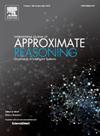Identifying total causal effects in linear models under partial homoscedasticity
IF 3
3区 计算机科学
Q2 COMPUTER SCIENCE, ARTIFICIAL INTELLIGENCE
引用次数: 0
Abstract
A fundamental challenge of scientific research is inferring causal relations based on observed data. One commonly used approach involves utilizing structural causal models that postulate noisy functional relations among interacting variables. A directed graph naturally represents these models and reflects the underlying causal structure. However, classical identifiability results suggest that, without conducting additional experiments, this causal graph can only be identified up to a Markov equivalence class of indistinguishable models. Recent research has shown that focusing on linear relations with equal error variances can enable the identification of the causal structure from mere observational data. Nonetheless, practitioners are often primarily interested in the effects of specific interventions, rendering the complete identification of the causal structure unnecessary. In this work, we investigate the extent to which less restrictive assumptions of partial homoscedasticity are sufficient for identifying the causal effects of interest. Furthermore, we construct mathematically rigorous confidence regions for total causal effects under structure uncertainty and explore the performance gain of relying on stricter error assumptions in a simulation study.
在部分均方差条件下,确定线性模型中的总因果效应
科学研究的一个基本挑战是根据观察到的数据推断因果关系。一种常用的方法是利用结构因果模型,假设相互作用的变量之间有噪声的函数关系。有向图自然地表示了这些模型,并反映了潜在的因果结构。然而,经典的可识别性结果表明,如果不进行额外的实验,这个因果图只能识别到不可区分模型的马尔可夫等价类。最近的研究表明,关注具有相等误差方差的线性关系可以使仅仅从观测数据中识别因果结构成为可能。尽管如此,从业者通常主要对特定干预措施的效果感兴趣,因此没有必要完全确定因果结构。在这项工作中,我们研究了在多大程度上限制性较小的部分同方差假设足以识别感兴趣的因果效应。此外,我们在结构不确定性下构建了数学上严格的总因果效应置信区域,并在模拟研究中探讨了依赖更严格的误差假设的性能增益。
本文章由计算机程序翻译,如有差异,请以英文原文为准。
求助全文
约1分钟内获得全文
求助全文
来源期刊

International Journal of Approximate Reasoning
工程技术-计算机:人工智能
CiteScore
6.90
自引率
12.80%
发文量
170
审稿时长
67 days
期刊介绍:
The International Journal of Approximate Reasoning is intended to serve as a forum for the treatment of imprecision and uncertainty in Artificial and Computational Intelligence, covering both the foundations of uncertainty theories, and the design of intelligent systems for scientific and engineering applications. It publishes high-quality research papers describing theoretical developments or innovative applications, as well as review articles on topics of general interest.
Relevant topics include, but are not limited to, probabilistic reasoning and Bayesian networks, imprecise probabilities, random sets, belief functions (Dempster-Shafer theory), possibility theory, fuzzy sets, rough sets, decision theory, non-additive measures and integrals, qualitative reasoning about uncertainty, comparative probability orderings, game-theoretic probability, default reasoning, nonstandard logics, argumentation systems, inconsistency tolerant reasoning, elicitation techniques, philosophical foundations and psychological models of uncertain reasoning.
Domains of application for uncertain reasoning systems include risk analysis and assessment, information retrieval and database design, information fusion, machine learning, data and web mining, computer vision, image and signal processing, intelligent data analysis, statistics, multi-agent systems, etc.
 求助内容:
求助内容: 应助结果提醒方式:
应助结果提醒方式:


